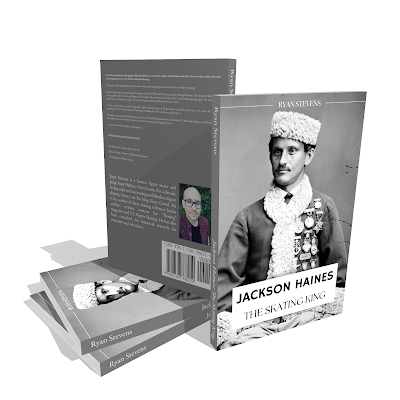Adrian Pryce-Jones (right) on the set of the film "Hobson's Choice". Photo courtesy British Film Institute.
The son of Marion (Dawnay) and Henry Morris Pryce-Jones, David Adrian Pryce-Jones was born September 13, 1919 in the town of Windsor, England. He had a privileged, upper-class upbringing. His father was a decorated Colonel in the Coldstream Guards. His grandmother was Lady Victoria Alexandrina Elizabeth Gray. The Duke of Newcastle-under-Lyne and the Earl of Wharncliffe were his uncles. He was also related to the managing director of the Pryce-Jones Department Store in Canada - once the Hudson's Bay Company's biggest competitor.
Adrian took up figure skating as a teenager and began pursuing the sport seriously while studying at Eton College. He regularly travelled to London to train with Arnold Gerschwiler at Richmond Ice Rink and within a few short years, earned the NSA's Gold Medal in Figures. In 1938, he won the bronze medal in the junior men's event and finished sixth in the senior men's event at the British Championships. In 1939, he repeated as the junior men's bronze medallist. He was hailed by reporters as the next 'big thing' in British men's skating - the heir apparent to the likes of Graham Sharp and Freddie Tomlins.
Photo courtesy "Skating World" magazine
Just as Adrian's star was rising in the figure skating world, World War II broke out in Europe. Like so many other young British skaters, he joined the military. He served with the Welsh Guards in North Africa and Italy, reaching the rank of Captain.
Henry Graham Sharp, Adrian Pryce-Jones and Arthur Apfel. Photo courtesy "Ice Skating" magazine.
After the War ended, Adrian staged a comeback to the figure skating world and won the bronze medal in the senior men's event at the 1946 British Championships, behind fellow servicemen Graham Sharp and Dennis Silverthorne. None of the men who entered had much practice, recalled Sharp, and "rehabilitation to civilian and family life [took] time." For Adrian and his rivals, participating in such an event before a large, clapping crowd may have been therapeutic to some; jarring to others. Adrian fell into the latter category, but still chose to return to compete one last time in 1948 in a bid to make the Olympic team. He again took the bronze, but dazzled the audience with his "well-known and surprising sit spin with his hands clasped behind his back." Retiring from competitive skating, hre served as a judge and on the NSA's Ice Figure Committee for a time.
At the same time he was competing, Adrian embarked on a career as a director. His credits included a stage adaptation of Agatha Christie's "Ten Little Indians" and the films "Moulin Rouge", "Summertime", "Time Without Pity", "Deep Blue Sea" and "Hell Is Sold Out". He worked with dozens of 'A List' stars including Katharine Hepburn, Laurence Olivier, Vivien Leigh, Rex Harrison, Zsa Zsa Gabor and Charles Laughton.
Adrian's success in the figure skating, film and theatre worlds and the fact he was a jovial man - the kind to entertain friends with impromptu piano performances at parties - made him quite popular. However, his private life led to his ultimate (premature) downfall. In his memoir "The Bonus Of Laughter", Adrian's brother (the author) Alan Pryce-Jones wrote, "It was only... in my forties that I came to know my brother. After the War, he went into the world of cinema, impelled by a brother-officer, Terence Young, and for some twenty years led a successful career with Carol Reed, Otto Preminger, and other good directors, working on such movies as 'Moulin Rouge' and 'Summertime', but never given the chance of setting up film on his own. To direct stars needs a special temperament; and it is on the first assistant-director that this need falls with special harshness. He had to calm the star's tantrums. He had to set up a location in, say, Tobago. He had to undertake prodigies of organization. And not this Adrian was not really suited. He was very efficient and very well-liked. But the strain of constant movement led him to drink a little, then to add to pills to vodka, then to drink a lot. Finally, he was going from nursing-home to nursing-home, too often becoming engaged to a fellow-alcoholic on the second floor. What can a brother do? I tried cajolement, tyranny, warning, sympathy. And at times all went well. Adrian was a delightful companion [though] he was unexpectedly shrewd, but years later, towards the end of his life, I remembered the advice of an American friend who had worked on 'Horizon' with Cyril Connolly, and suffered from a sister afflicted with periodical bouts of drunkenness. 'There is only one thing to do,' Tony Bower had said, 'with an alcoholic. Ask them to stay. Furnish their room with cases of liquor and bottles of pills, and hope it won't take too long' - brutal advice, but comprehensible." After Adrian's father's death in 1952, his mother gave him a small inheritance, which he apparently squandered on brandy. He passed away in St. Moritz, Switzerland on December 15, 1968, at the age of forty-nine.
Skate Guard is a blog dedicated to preserving the rich, colourful and fascinating history of figure skating. Over ten years, the blog has featured over a thousand free articles covering all aspects of the sport's history, as well as four compelling in-depth features. To read the latest articles, follow the blog on Facebook, Twitter, Pinterest and YouTube. If you enjoy Skate Guard, please show your support for this archive by ordering a copy of figure skating reference books "The Almanac of Canadian Figure Skating", "Technical Merit: A History of Figure Skating Jumps" and "A Bibliography of Figure Skating": https://skateguard1.blogspot.com/p/buy-book.html.





















































